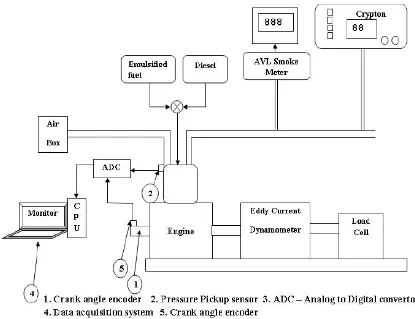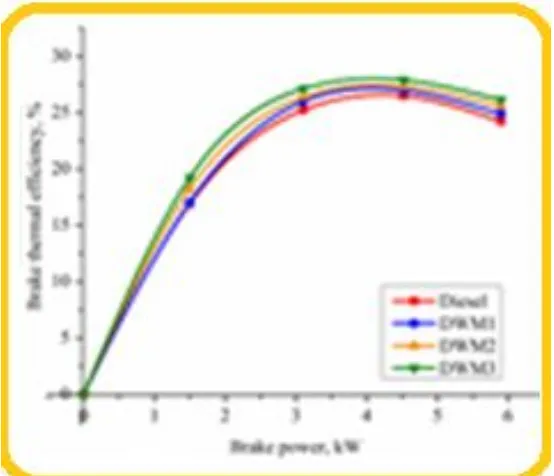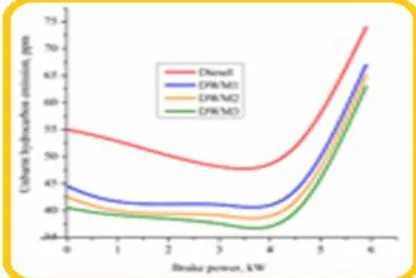Experimental Analysis on Performance and
Emission Characteristics in DI Diesel Engine an
Effect of Emulisifed Fuel
J. Murali Naik1, Dr. B. Anjaneya Prasad2 1
Research Scholar Department of Mechanical Engineering JNTUACEA, Ananthapuramu, Andhra Pradesh, India. 2
ProfessorDepartment of Mechanical Engineering JNTUHCEH, Hyderabad,, India.
Abstract: The main aim of this experimental work is to compare the overall performance and emission characteristics of emulsified fuel inside the conventional engine. A single cylinder direct injection diesel engine has been used for this investigation. Diesel water emulsion has been chosen because the test fuel and diesel has been taken into consideration because the reference fuel. As the diesel and water are immiscible, surfactants have been used to form a homogeneous combination called emulsion. The surfactants used are span 80 and tween 80. Water has been combined for the proportions of 4%, 8%, and 12% by way of volume with diesel. For all the emulsions, 1% of surfactant has been used. It was found that the brake thermal efficiency almost nearly close to diesel and simultaneous reduction of smoke and oxides of nitrogen (NOx) emission. Suggested scope for this experimental investigation is probably an endurance test and fuel additive to increase the calorific value.
Keywords: Emulsified fuel, surfactants, brakes thermal efficiency, oxides of nitrogen (NOx) emission.
I. INTRODUCTION
Emulsified fuels have been under research studies for more than three decades, as it reduces the oxides of nitrogen and smoke simultaneously. But, due to the concentration of researchers toward the vegetable oil, and biodiesel there was gradual down within the area of emulsified fuels. Mohammed et al., 2014; reviewed present status of emulsified fuels in diesel engines, and he mentioned that introducing the water in to cylinder will be achieved in three specific strategies. The three techniques are introduction of water with the inlet air in liquid or vapour form, parallel water and diesel injection and diesel in water emulsion. Alam et al., 2013; performed an experimental work on a single cylinder DI diesel engine, with diesel water emulsion as fuel by changing the load. The study revealed that there has been reduction in exhaust gas temperature and carbon monoxide (CO) emission in all load situations. Micro explosion occurring at some stage in the combustion makes a unexpected drop in temperature which reduces the oxides of nitrogen (NOx) emission. Secondary atomization occurs for the duration of combustion reduces the smoke emission, by way of entire combustion. Prakash et al., 2012; performed an analysis on performance, combustion, and emission traits of wood Pyrolysis Oil (WPO) and concluded that brake thermal efficiency became better with the fuel additive Di Ethyl Ether (DEE). As water has no calorific value, and DEE has a maximum cetane range (125) this attempt might were made. Narkpakdee et al., 2012; carried out a study with Crude Palm Oil (CPO) emulsion as fuel, in a small diesel engine. They have reported said that overall performance parameters appeared to be negative while the composition of CPO was improved. The purpose might be due the decreased calorific value inside the palm oil while in comparison with diesel. Agung et al., 2011; accomplished an investigation with diesel-water emulsion as fuel in a single cylinder diesel engine. They used 10% water with diesel with organic surfactant. The result of the experimental work, was reduced CO, and NOx emission. Secondary atomization occurred all through the combustion could be cause, which led to a homogeneous combustion. Pradeep kumar et al., 2013; performed an experimental investigation with diesel-water emulsion with diesel-water content varying from 5% to 8%. The result of the experimental reveal that there has been simultaneous reduce of smoke and oxides of nitrogen emission. In this experimental work, it is planned to increase the content of water up to 12%.
A. Effects Of Introducing Water Into Combustion Chamber
temperature when water emulsion is sprayed into the combustion chamber. In a examine via Ki (2000), it become reported that addition of water in the fuel delays the start of combustion and a reduction in the amount of soot because the water content is increase.
B. There are several methods to introduce water into combustion chamber:
They are
1) Direct water injection
2) Intake air humidification
3) Water in fuel emulsion
C. Direct water injection
In this system a separate injection system would be assembled with the engine to introduce water by a separate injector. Therefore this gadget calls for separate pumps and not unusual rail gadget might be really helpful. In this system water might be directed into the combustion chamber and time of injection would be adjusted accordingly. The advantage of this system is injecting system are separate for fuel and water. Quantity of water to inject will be regulated with the by a separate valve.
D. Intake air humidification
In this system water may be directed into the air and subsequently there could be homogeneous distribution of water inside the engine cylinder. In his take a look at Berisa (2007) cited that there was a reduction 40% of oxides of nitrogen emission. The researcher has experimented with pressurized water addition with the intake air after the turbocharger compression.
E. Water-fuel emulsion
In emulsified fuels water is mixed with fuel. The mixing takes place in a homogenizer and the emulsified fuel is injected into the cylinder the usage of the fuel injecting system. In this type of fuel additional injecting equipment isn't required. When in comparison to direct injection of water and intake air humidifying system, the major benefit is that the engine does not require any major modification and the same injecting system might be used.
II. DIESEL-WATER EMULSION AS AN ALTERNATIVE FUEL
Diesel-water emulsion is the only alternative for diesel fuel and it does not require any major modification inside the engine structure. As diesel and water are immiscible, non ironic surfactants are used to shape an emulsified fuel. With the aid of its appearance emulsified fuel looks like a precipitated form of milk or curd. It has the advantage of accomplishing reduced inside the concentration of diesel’s major regulated pollutants NOx and particulates. It doesn’t have an effect on unregulated pollution along with aldehydes, ketones etc. The presence of water will increase the flash point of the emulsion by ~ 40ºC. The water amount within the diesel can be around 20% by way of quantity. When emulsified fuels have been used, it become found that the torque and engine power were slightly different from diesel but specific fuel consumption changed into higher with the amount of water composition (Nark pakdee et al 2012). When adding the water content to the fuel and changing corresponding quantity of fuel, it wsa found to result in lower combustion temperature (Agung et al 2011). The reduction in combustion temperature substantially reduces the emission parameters.
III. COMBUSTION PROCESS WITH CONVENTIONAL FUEL AND EMULSIFIED FUEL
When the diesel fuel is sprayed into the combustion chamber, it is atomized into fine droplets with the size varying from 25 microns to 100 microns. Since the surface of the fuel alone is exposed to the air, larger size fuel droplets do not burn completely and un burnt hydrocarbons and particulate matter are left in the exhaust fuel.
When the emulsified fuel is sprayed into the combustion chamber, secondary atomization takes place because of rapid transformation of water content into steam. This phase transformation of water into steam shatters the base fuel surrounding the water into tiny droplets, which are still lesser in length than combustion taking place with the conventional fuel. Those smaller droplets of fuel could have more surface area, thereby enhancing the method of combustion. That is an exclusive character of emulsified fuels and it is known as secondary atomization. This secondary atomization because of conversion of water into steam reduces the peak combustion temperature and therefore emission of NOx is reduced.
Table1: List of manufactures of emulsified fuel, product’s name, and water content in the fuel
Company Product Name Water content
CAM Tecnologie Gecam 10-11%
Clean fuels technology Aqua diesel 13%
Lubrizol PuriNOx, Qwhite,
Aspira
10-20%
Total Aqua Zole 14-17
A. Advantages Of Using Emulsified Fuels
Simultaneous reduction of NOx and smoke is possible with emulsified fuels.
Emulsified fuels do not affect the concentration of unregulated pollutants such as aldehydes ketones, and poly aromatic hydrocarbons.
Normal water can be used instead of distilled water for preparing emulsified fuels.» Engine does not require any major modification and is independent of age and technology.
The flash point of emulsified fuel increases and hence storage safety measure is better than diesel.
B. Disadvantages Of Using Emulsified Fuels
Emulsified fuels have lower calorific value, as water has no energy value.
Long term storage of water emulsion is a concern, as there is a problem of stability. There is a possibility of adulteration of using emulsified fuel.
Table2: Composition of emulsified fuels
DWM1 DWM2 DWM3
Diesel 95% 91% 87%
Water 4% 8% 12%
Span80 0.5% 0.5% 0.5%
Tween80 0.5% 0.5% 0.5%
Table3: Comparison of fuel properties of diesel and diesel-water emulsion
Diesel DWM1 DWM2 DWM3
Density(kg/m3) 830 833 836 841
Calorific value (MJ/kg)
43.2 40.72 38.48 36.32
Flash point(ºC) 56 58 60 62
Fire point (ºC) 64 65 66 68
C. Visual Study Of Emulsified Fuel
Fig1: Photograph taken during visual study of diesel-water emulsion
[image:5.612.98.513.319.638.2]IV. EXPERIMENTAL SETUP AND ENGINE SPECIFICATION
Figure 2show the experimental setup used for the investigation. The flay out consist a Kirloskar SV 1 brand engine, coupled with an eddy current loading. Windows based software program used in records acquisition system, that is used for plotting pressure and crank angle graph and heat released rate. To measure the exhaust parameters smoke meter and gas analyzer have been used. Fuel intake were separated for diesel and diesel-water emulsion. The specification of engine had been indexed inside the table 4.
Figure 2: Experimental setup
A. Experimental Procedure
Table 4: Specifications of Engine
V. RESULTS AND DISCUSSION
A. Performance and Emission Analysis
[image:6.612.169.446.379.617.2]1) Brake power Vs brake thermal efficiency: Figure 3 shows the curve between brake power and brake thermal efficiency. It was observed that there was an increase in efficiency by 1.24%, 3.09%, and 5.3% with DWM1, DWM2, and DWM3 respectively when compared with petroleum diesel. The presence of water in the emulsion increased the expansion work and reduced the compression work resulting in increased net work done during the cycle. Anna et al., 2006; had mentioned that addition of water in the form of emulsion had the positive effect on the combustion efficiency as the water droplets created additional torque and developed maximum pressure.
Fig.3 Brake Thermal Efficiency Vs brake thermal efficiency
Figure 4: Brake thermal efficiency Vs specific fuel consumption
[image:7.612.204.410.332.489.2]3) Cylinder pressure Vs crank angle: Figure 5 shows the curve between cylinder pressure and crank angle. There was an increase in peak pressure for DWM1, DWM2, and DWM3 by 1.01%, 2.88%, and 4.93% respectively, when compared with diesel. Explosive vaporization occurred when the fuel was injected into the engine, fragmenting the droplets further. Anna et al., 2006; mentioned that addition of water increased the torque over the entire rpm range. Hence when the charge was fired in the cylinder, water turned into steam with high pressure.
Figure 5: Cylinder pressure Vs crank angle graph
4) Unburnt hydrocarbon emission: Figure 6 shows the characteristic curve between brake power and unburnt hydrocarbon emission. The HC emission was found to be 74 ppm for diesel fuel at maximum load. It was also observed that the HC emission was reduced by 9.46%, 12.17%, and 14.88% with DWM1, DWM2, and DWM3 respectively. The smoother and homogeneous combustion enabled the reduction of hydrocarbon emission with emulsified fuels. A similar result was reported by Nitesh (2012) in his study. He stated that unburnt hydrocarbon emission emulsified fuel significantly lesser than diesel fuel.
[image:7.612.200.408.576.715.2]5) Smoke opacity emission: Figure 7 shows the graph between brake power and smoke opacity emission. The decrease in smoke opacity emission was found to be 2 HSU, 3 HSU, and 5 HSU for DWM1, DWM2, and DWM3 respectively. Increase in ignition delay improved the mixing and explosion of water droplets resulted in better thermal cracking. Hence smoke opacity of emulsified fuels was lesser than diesel fuel. Similar findings were reported by Kannan and Marappan, 2010; that water emulsified fuels showed considerable reduction in smoke opacity compared to biodiesel, because water got vaporized by absorbing heat energy during combustion process.
Figure 7: Brake power Vs smoke opacity emission
6) Oxides of nitrogen (NOx) emission: Figure 8 shows the graph between brake power and oxides of nitrogen emission. The NOx emission was found to be decreased by 23.37%, 26.96%, and 29.6% with DWM1, DWM2, and DWM3 respectively when compared to diesel. Due to the explosion of water droplets OH radicals were produced and there was an improvement in air fuel mixing process. Moreover emulsified fuels produced lower heat release rate at premixed combustion which was at peak of combustion temperature, hence there was reduction in NOx emission (Roila and Choo 2008).
Figure8: Brake power Vs Oxides of nitrogen emission
VI. CONCLUSIONS
he experimental work proves that diesel-water emulsion can be used as a fuel in the compression ignition engines, without any modification. Though it doesn’t replace the petroleum fuel completely, using 12% of water per litre of diesel, could lengthen the availability of fossil fuel. The compatibility of the fuel has also been proved in this work, due to the following reasons.
Simultaneous reduction of smoke and oxides of nitrogen was possible with this fuel There was increase in brake thermal efficiency.
There was increase in the peak pressure developed.
There was reduction in hydrocarbon and carbon monoxide emission.
VII. ACKNOWLEDGEMENT
I am sincerely thanks my respected Supervisor Dr. B. ANJANEYA PRASAD, Professor, Department of Mechanical Engineering, JNTUCEH, Hyderabad for his motivation and guidancein publishing the paper.
REFERENCES
[1] Agung Sudrajad, Fujita Hirotsugu and Ismail Ali, Experimental Study of Exhaust Emissions of W/O Emulsion Fuel in DI Single Cylinder Diesel Engine, Modern Applied Science, 5, 2011, 74-79.
[2] lam Fahd E, Wenming Y, Lee P Chou S, and Yap C, Experimental investigation of the performance and emission characteristics of direct injection diesel engine by water emulsion diesel under varying engine load condition, Applied Energy, 102, 2013, 1042–1049
[3] Anna Lif and Krister Holmberg, ‘Water-in-diesel emulsions and related systems’, Advances in Colloid and Interface Science, 123, 2006, 231-239.
[4] Kannan TK and Marappan R, ‘Study of Performance and Emission Characteristics of a Diesel Engine using Thevetia Peruviana Biodiesel with Diethyl Ether Blends’, European Journal of Scientific Research, 43, 2010, 563-570.
[5] Mohammed Yahaya Khan, Abdul Karim ZA, Ftwi Yohaness Hagos, Rashid A, Aziz A, and Isa, Current Trends in Water-in-Diesel Emulsion as a Fuel’, Hindawi Publishing Corporation, The Scientific World Journal, 2014, 3-14.
[6] Narkpakdee J, Permsuwan A, Deethayat T, and Kiatsiriroat T, Performance and Emission of Small Diesel Engine Using Diesel-Crude Palm Oil-Water Emulsion as Fuel, Energy Science and Technology, 3, 2012, 38-45.
[7] Nitesh kumar singh, ‘An experimental investigation of diesel emulsions as fuel in small Direct Injection Compression Ignition engines’, MIT International Journal of Mechanical Engineering, 2, 2012, 39–44.
[8] Pradeep kumar Arockiasamy Remigious, Annamalai Kandasamy and Premkartikkumar Selvi Ramajayam, ‘An Experimental Investigation into Chosen Parameters of Diesel-Water Emulsion on Combustion Processes’, Journal of Chemistry, Hindawi publishing corporation, 2013,1-6.



